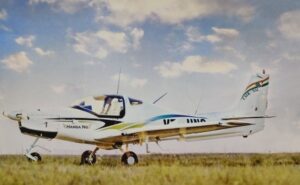GS3 – Science & Technology – Defense Sector

In a significant milestone, CSIR–NAL (National Aerospace Laboratories) has signed its first aircraft technology transfer agreement with a private firm to manufacture Hansa-3 NG, India’s first indigenously developed trainer aircraft designed for commercial pilot instruction.
Overview of Hansa-3 NG
Hansa-3 NG is a next-generation, two-seater light trainer aircraft featuring a low-wing, all-composite design, developed entirely by CSIR–NAL. The aircraft is nearly 50% more affordable than imported alternatives, such as the Cessna 152 and 172, making it highly cost-effective for training institutions.
Primary Usage:
- Designed specifically for initial flight training (ab-initio) in flying schools.
- Also tailored for defence training modules, NCC cadet instruction, and coastal patrolling.
- An electric variant, named E-HANSA, is currently under development to promote environment-friendly aviation solutions.
Key Technical Features
- Engine: Fitted with the Rotax 912 iSc3 Sport, a digitally controlled, fuel-efficient engine.
- Control Systems: Equipped with electrically operated flaps to enhance operational ease.
- Airframe: Constructed using carbon fiber and fiberglass composites, ensuring strength while reducing weight.
- Avionics: Features a digital glass cockpit, offering enhanced situational awareness and modern navigation capabilities.
Rationale Behind Development
- Aimed at reducing India’s dependency on expensive, foreign-manufactured trainer aircraft.
- Addresses the critical shortage of training aircraft required for issuing Private Pilot Licences (PPL) and Commercial Pilot Licences (CPL).
- Enables the decentralisation of pilot training, lowering the cost and increasing access to aspiring aviators across regions.
- Responds to the skyrocketing demand for pilots, in light of India’s rapidly expanding aviation industry.
Current and Future Demand Landscape
- India holds the third-largest aviation market globally, with expectations of requiring nearly 30,000 new pilots over the next 15 to 20 years.
- To operate each aircraft:
- Narrow-body jets need around 15–20 trained pilots.
- Wide-body aircraft require 25–30 trained pilots.
- This translates into a requirement of over 750 trainer aircraft to bridge the upcoming training demand-supply gap.
About CSIR–NAL
- CSIR–NAL, located in Bengaluru, is the only civilian aerospace R&D institute in India functioning under the Council of Scientific and Industrial Research (CSIR).
- Founded in 1959 and later renamed from the National Aeronautical Research Laboratory in 1993, the lab is governed by the Ministry of Science and Technology.
- Its work supports both national aerospace initiatives and partnerships with the private sector.
Core Focus Areas:
- Design and testing of indigenous aircraft
- Development of aerospace technologies and simulation systems
- Strengthening the foundation of India’s self-reliant aviation ecosystem




